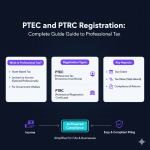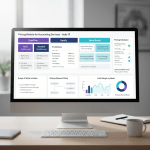Key takeaways
- AI journal entry suggestions act like a tireless junior accountant, they learn your patterns, then draft entries you can approve, edit, or reject.
- For Indian SMBs and CA firms, the biggest wins are faster closes, fewer errors, and stronger GST, TDS compliance, all with a searchable audit trail.
- High confidence suggestions can auto post within thresholds, low confidence drafts always route for human review, you stay in control.
- Recurring journals, prepaid recognition, accruals, and smart adjustments see the fastest automation gains, freeing time for analysis.
- Success depends on clean mappings, phased rollout, good thresholds, and continuous optimization, not on big bang change.
- Security matters, insist on ISO 27001, SOC 2 Type 2, robust encryption, and complete audit logs before scaling.
- Tools purpose built for India, like AI Accountant, handle Tally, Zoho, GST, TDS, and Indian bank statements natively.
Table of contents
What Are AI Journal Entry Suggestions?
Think of AI journal entry suggestions as your smartest assistant who never sleeps. These systems analyze your ledgers and documents, then propose draft journals based on patterns, rules, and historical behavior.
What makes them special for Indian businesses is their grasp of local nuance, UPI narrations, NEFT codes, smart narration parsing for Indian statements, GST splits, TDS sections, and more. Bank statements are ingested via OCR tuned to Indian formats, vendor bills and invoices sync from Tally or Zoho, and prior journals power learning.
Pattern recognition surfaces recurring amounts, recurring dates, and typical vendors. Schedule driven templates cover predictable entries, complete with optional auto reversals. Rule based intelligence applies India specific logic for GST, TDS, and banking charges.
Each suggestion ships with a confidence score. High confidence items can auto post if you permit, lower confidence drafts always queue for review. You see the rationale, the source links, and the audit trail, then approve, edit, or reject. This is not replacement, this is amplification.
Further reading: Journal entry automation secrets, India, AI agents for journal entry processing
Core Benefits of AI-Powered Journal Suggestions
Faster Month End Close
Remember those 10 day closes that spill into the second week? AI suggestions cut that time dramatically, see period end closing automation in India. The system prepopulates recurring entries before month end arrives, flags adjustments early, and lets you focus on exceptions, not everything.
Error Reduction Through Pattern Detection
Manual posting invites human error. AI flags duplicates, misclassifications, and GST code mistakes before they flow into returns. Each correction teaches the model, so accuracy compounds month over month.
Compliance Automation for Indian Regulations
GST split logic, TDS sections and thresholds, PF, ESI, and PT calculations, all can be automated. When filing time arrives, your books are already clean.
Audit Trail and Documentation
Every suggestion and decision is logged, with linked source documents and timestamps. Come audit time, you export evidence packs in minutes.
Time Savings for Repetitive Tasks
Rent, depreciation, salaries, subscriptions, and other repeats run on autopilot. You review exceptions, then spend reclaimed hours on analysis.
References: Journal entry automation secrets, India, Journal entry processing with AI agents
Five Game-Changing Use Cases for Indian Businesses
1. Proposing Smart Adjustments
Misclassifications and rounding issues are common. The AI spots anomalies, drafts the correcting journal, and explains the rationale. Example, a narration with quarterly bank charges gets split across cost centers per your historical pattern, with links back to the source transaction and a clear comment trail.
Pro tip: Let adjustments run as suggestions for the first month, then permit auto posting for low value, high confidence items.
Source: Journal entry automation secrets, India
2. Automating Recurring Journals
Templates for rent, depreciation, insurance, software, and salaries generate entries on schedule, with optional auto posting. Changes in amount trigger flags, missed occurrences alert before month end, and reversals handle temporaries. One client cut recurring work from six hours to thirty minutes.
Sources: AI based journal entry processing, Automation secrets for India
3. Managing Prepaid Expense Recognition
When a bill is tagged as prepaid, the system schedules monthly recognition, links each release to the original bill, and keeps balances visible. Cancellations suggest reversals automatically, and GST implications stay aligned with your policy.
Reference: Journal entry automation secrets, India
4. Streamlining Accrual Posting
The AI monitors open POs, delivery patterns, and typical vendor timelines, then suggests accruals with proper GST split and auto reversal. For revenue, it proposes unbilled services accruals with clear reasoning, keeping books accurate without manual tracking.
Reference: Journal entry automation secrets, India
5. Providing Variance Analysis Hints
Beyond flagging variances, the system suggests likely causes and drafts corrective entries. Office expenses up because rent stepped up, revenue down because a recurring invoice failed, cost spikes traced to a one time payment, all surfaced with links and proposed journals.
Reference: Journal entry automation secrets, India
Step-by-Step Implementation Guide
Phase 1: Connection and Setup
Connect Tally or Zoho via API, upload recent bank statements, and configure mappings. For mappings, see ledger mapping automation for Tally and Zoho. Define roles and approvals to preserve controls.
Phase 2: Module Activation
Start with recurring journals for quick wins, then enable adjustment proposals, prepaid management, accruals, and variance hints as confidence grows.
Phase 3: Threshold Configuration
Set materiality and confidence thresholds. For example, allow auto posting below a value cap with very high confidence, require review above caps, and lock periods to prevent out of period activity.
Phase 4: Pilot Testing
Run a pilot on one or two entities, measure suggestion accuracy, time saved, audit trail completeness, and control adherence. Iterate based on findings.
Phase 5: Rollout and Optimization
Scale gradually, track acceptance rates, error trends, and time to close. Review rejected suggestions, refine rules, and keep training with new data.
Guide: Journal entry automation secrets, India
Best Practices for Indian Compliance
GST Handling Excellence
- Configure local versus interstate logic correctly, CGST and SGST for local, IGST for interstate.
- Enable reverse charge rules where applicable.
- Match suggestions to GSTR 2B, flag mismatches before filing.
- Track input credit eligibility per your policies.
TDS Precision
- Map vendor categories to sections, for example 194J for professionals, 194C for contractors, 194I for rent.
- Respect thresholds by tracking cumulative payments.
- Apply accrual versus payment logic by section.
- Populate entries with section codes and rates in the narration.
Multi Entity Considerations
- Define intercompany rules and elimination logic for consolidation.
- Set entity specific thresholds and approvals.
- Enable group level variance views while maintaining entity ledgers.
Reference: Journal entry automation secrets, India
Measuring Success: KPIs That Matter
Efficiency Metrics
- Time to close, days from period end to final books.
- Entries per hour, a clear productivity signal.
- Recurring automation rate, aim for ninety percent plus.
- First time accuracy, entries posted correctly the first time.
Quality Metrics
- Post close adjustments, fewer is better.
- Audit findings, track reduction in observations.
- Variance investigation time, target sharp declines.
- Error rates by category, focus fixes where needed.
Adoption Metrics
- Suggestion acceptance rate, a proxy for trust and configuration quality.
- User login frequency, ensures active engagement.
- Module utilization, identify underused features that need training.
- Feedback scores, capture qualitative sentiment and ideas.
Business Impact Metrics
- Working capital optimization from accurate accruals.
- Compliance penalties avoided through timely, accurate filings.
- Audit fee trends as books and evidence improve.
- Team satisfaction as routine work reduces.
Top Tools for Journal Entry Automation
- AI Accountant, purpose built for Indian SMBs with deep Tally and Zoho integration, OCR for Indian bank statements, and comprehensive GST, TDS handling, plus ISO 27001 and SOC 2 Type 2 certifications.
- QuickBooks Online, basic automation and recurring templates, less India specific depth.
- Xero, journal templates and reconciliation automation for recurring scenarios.
- Zoho Books, native automation for India with GST and recurring journals.
- FreshBooks, simple recurring features for small teams.
- Tally Prime, powerful with customization, requires setup and technical know how.
Security and Compliance Considerations
Data Security Standards
- Insist on ISO 27001 and SOC 2 Type 2.
- Encrypt data in transit and at rest.
- Use role based access and exhaustive audit logs.
Regulatory Compliance
- Stay current on GST rules and rates through automatic updates.
- Verify TDS logic and frequent rule changes.
- Maintain complete audit trails for every entry.
- Confirm data residency if your policy requires Indian storage.
Integration Security
- Secure APIs for Tally and Zoho sync.
- Strong authentication, preferably multi factor.
- Session timeouts and secure session handling.
- Regular backups and tested recovery procedures.
Further reading: Journal entry automation, India, AI agents for journal workflows
Common Challenges and Solutions
User Resistance
Teams may worry about replacement or accuracy. Position AI as an assistant, start with volunteers, and share early wins to build trust.
Data Quality Issues
Standardize vendors, narrations, and categories during implementation, then enforce quality going forward. Better data means better suggestions.
Integration Complexities
Use providers who understand Tally quirks and Zoho patterns, plan sandbox tests, and keep fallback procedures ready.
Customization Requirements
Pick systems that allow rule configuration and templates, then document customizations to ease training and continuity.
The Future of AI in Indian Accounting
Predictive Analytics
From suggesting to predicting, cash flow and working capital forecasts will derive from journal patterns, letting teams plan proactively.
Natural Language Processing
Conversational commands, for example “create accrual for ABC, twenty five thousand, GST applicable,” will draft entries instantly.
Real Time Processing
Continuous close becomes the norm as bank feeds via Account Aggregator frameworks deliver instant suggestions.
Advanced Pattern Recognition
Seasonality, hidden correlations, and fraud indicators surface automatically, moving finance from recording to predicting.
Autonomous Compliance
Systems will track rule changes, update GST and TDS logic, and prepare returns from clean ledgers with minimal intervention.
Conclusion: Your Next Steps
AI journal entry suggestions are already transforming Indian closes. Start small, pick your biggest pain point, implement, and measure. As confidence grows, enable more modules, tweak thresholds, and keep optimizing.
Bottom line: This is not about replacing judgment, it is about elevating it. Machines handle the repetitive, you focus on analysis and insight.
Your cleaner, faster, stress free close is within reach. Take the first step today.
FAQ
How do AI journal entry suggestions actually learn my ledger behavior in Tally or Zoho Books?
They analyze historical journals, bank narrations, vendor patterns, and approval outcomes, then weight features to predict likely debits and credits. Tools like AI Accountant ingest Indian bank statements and Tally or Zoho transactions, building pattern libraries that improve with each correction you make.
As a CA, what controls stop an AI suggestion from posting a wrong entry?
You set confidence thresholds, approval hierarchies, and period locks. Low confidence items never auto post, high confidence items can auto post only within your materiality limits. Every action is logged, and AI Accountant supports dual approvals for sensitive entries.
Can AI handle India specific GST logic, including CGST, SGST, IGST, and reverse charge?
Yes, if configured correctly. AI Accountant maps place of supply and registration state to split GST, applies reverse charge where relevant, and aligns suggestions with GSTR 2B matching to flag exceptions before filing.
How does the system recognize UPI, NEFT, and Indian bank narrations reliably?
Through narration parsing models trained on Indian statement formats and vendors. For example, AI Accountant uses models tuned for UPI handles and NEFT codes, which improves identification of bank charges, fees, and vendor references, reducing manual tagging.
What is the fastest area to automate first during a month end close?
Recurring journals, rent, depreciation, software subscriptions, and salaries. Set templates, decide auto posting thresholds, and let the system run. Many firms see immediate time savings in the first close cycle with AI Accountant.
How are prepaid expenses and amortization schedules managed end to end?
When a bill is marked prepaid, the AI builds a recognition schedule, posts monthly releases, links each release to the source bill, and proposes reversals on cancellation. AI Accountant keeps the remaining balance visible and ensures narration traceability for audits.
What does good KPI tracking look like for AI driven close processes?
Track time to close, suggestion acceptance rate, recurring automation rate, first time accuracy, and post close adjustments. For example, firms using AI Accountant often target ninety percent automation for recurring entries and a fifty percent reduction in close time.
How do I validate accuracy before scaling to all entities in a group?
Run a pilot on one or two entities, review suggestion accuracy and audit trails, and reconcile variances. Use findings to refine mappings and thresholds, then roll out progressively. AI Accountant’s entity level controls make phased deployments straightforward.
What security certifications should I require from an AI accounting vendor?
ISO 27001 for information security and SOC 2 Type 2 for ongoing control effectiveness. Ensure encryption at rest and in transit, role based access, and complete audit logs. AI Accountant adheres to these standards and supports data residency needs.
Will AI reduce audit effort, and if yes, how?
Yes, because every suggested entry carries rationale, linked evidence, timestamps, and approval records. Auditors receive complete evidence packs faster, reducing queries and time spent on sampling. Firms using AI Accountant often report fewer observations and smoother audits.
Can the AI detect and prevent duplicate or misclassified entries during busy close days?
Duplicate detection compares amounts, dates, vendors, and narration patterns, while classification models flag outliers against historical posting behavior. Reviewers focus on exceptions, not everything, and systems like AI Accountant learn from every approved correction.
How do I set materiality and confidence thresholds that match my risk appetite?
Start conservative, for example, allow auto posting only below a low value with very high confidence, and require review above that. Then tune based on acceptance rates and error trends. AI Accountant provides granular thresholds by module and entity, so you can calibrate precisely.




